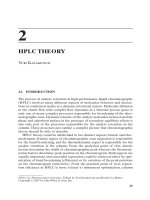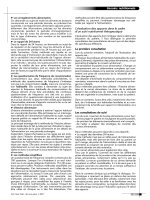Chapter 036. Edema (Part 2) pptx
Bạn đang xem bản rút gọn của tài liệu. Xem và tải ngay bản đầy đủ của tài liệu tại đây (80.61 KB, 5 trang )
Chapter 036. Edema
(Part 2)
Reduction of Effective Arterial Volume
In many forms of edema, the effective arterial blood volume, a parameter
that represents the filling of the arterial tree, is reduced. Underfilling of the arterial
tree may be caused by a reduction of cardiac output and/or systemic vascular
resistance. As a consequence of underfilling, a series of physiologic responses
designed to restore the effective arterial volume to normal are set into motion. A
key element of these responses is the retention of salt and, therefore, of water,
ultimately leading to edema.
Renal Factors and the Renin-Angiotensin-Aldosterone (RAA) System
(See also Chap. 336) In the final analysis, renal retention of Na
+
is central
to the development of generalized edema. The diminished renal blood flow
characteristic of states in which the effective arterial blood volume is reduced is
translated by the renal juxtaglomerular cells (specialized myoepithelial cells
surrounding the afferent arteriole) into a signal for increased renin release (Chap.
336). Renin is an enzyme with a molecular mass of about 40,000 Da that acts on
its substrate, angiotensinogen, an α
2
-globulin synthesized by the liver, to release
angiotensin I, a decapeptide, which is broken down to angiotensin II (AII), an
octapeptide. AII has generalized vasoconstrictor properties; it is especially active
on the efferent arterioles. This efferent arteriolar constriction reduces the
hydrostatic pressure in the peritubular capillaries, while the increased filtration
fraction raises the colloid osmotic pressure in these vessels, thereby enhancing salt
and water reabsorption in the proximal tubule as well as in the ascending limb of
the loop of Henle.
The RAA system has long been recognized as a hormonal system; however,
it also operates locally. Intrarenally produced AII contributes to glomerular
efferent arteriolar constriction, and this "tubuloglomerular feedback" causes salt
and water retention. These renal effects of AII are mediated by activation of AII
type 1 receptors, which can be blocked by specific antagonists [angiotensin
receptor blockers (ARBs)].
The mechanisms responsible for the increased release of renin when renal
blood flow is reduced include: (1) a baroreceptor response in which reduced renal
perfusion results in incomplete filling of the renal arterioles and diminished stretch
of the juxtaglomerular cells, a signal that increases the elaboration and/or release
of renin; (2) reduced glomerular filtration, which lowers the NaCl load reaching
the distal renal tubules and the macula densa, cells in the distal convoluted tubules
that act as chemoreceptors and that signal the neighboring juxtaglomerular cells to
secrete renin; and (3) activation of the β-adrenergic receptors in the
juxtaglomerular cells by the sympathetic nervous system and by circulating
catecholamines, which also stimulates renin release. These three mechanisms
generally act in concert to enhance Na
+
retention and, thereby, contribute to the
formation of edema.
AII that enters the systemic circulation stimulates the production of
aldosterone by the zona glomerulosa of the adrenal cortex. Aldosterone, in turn,
enhances Na
+
reabsorption (and K
+
excretion) by the collecting tubule. In patients
with heart failure, not only is aldosterone secretion elevated but the biologic half-
life of aldosterone is prolonged, which increases further the plasma level of the
hormone. A depression of hepatic blood flow, especially during exercise, is
responsible for reduced hepatic catabolism of aldosterone. The activation of the
RAA system is most striking in the early phase of acute, severe heart failure and is
less intense in patients with chronic, stable, compensated heart failure.
Increased quantities of aldosterone are secreted in heart failure and in other
edematous states, and blockade of the action of aldosterone by spironolactone (an
aldosterone antagonist) or amiloride (a blocker of epithelial Na
+
channels) often
induces a moderate diuresis in edematous states. Yet, persistently augmented
levels of aldosterone (or other mineralocorticoids) alone do not always promote
accumulation of edema, as witnessed by the lack of striking fluid retention in most
instances of primary aldosteronism (Chap. 336). Furthermore, although normal
individuals retain some NaCl and water with the administration of potent
mineralocorticoids, such as deoxycorticosterone acetate or fludrocortisone, this
accumulation is self-limiting, despite continued exposure to the steroid, a
phenomenon known as mineralocorticoid escape. The failure of normal
individuals who receive large doses of mineralocorticoids to accumulate large
quantities of extracellular fluid and to develop edema is probably a consequence of
an increase in glomerular filtration rate (pressure natriuresis) and the action of
natriuretic substance(s) (see below). The continued secretion of aldosterone may
be more important in the accumulation of fluid in edematous states because
patients with edema secondary to heart failure, nephrotic syndrome, and hepatic
cirrhosis are generally unable to repair the deficit in effective arterial blood
volume. As a consequence, they do not develop pressure natriuresis.
Arginine Vasopressin (AVP)
(See also Chap. 334) The secretion of AVP occurs in response to increased
intracellular osmolar concentration, and by stimulating V
2
receptors, AVP
increases the reabsorption of free water in the renal distal tubule and collecting
duct, thereby increasing total-body water. Circulating AVP is elevated in many
patients with heart failure secondary to a nonosmotic stimulus associated with
decreased effective arterial volume. Such patients fail to show the normal
reduction of AVP with a reduction of osmolality, contributing to edema formation
and hyponatremia.









